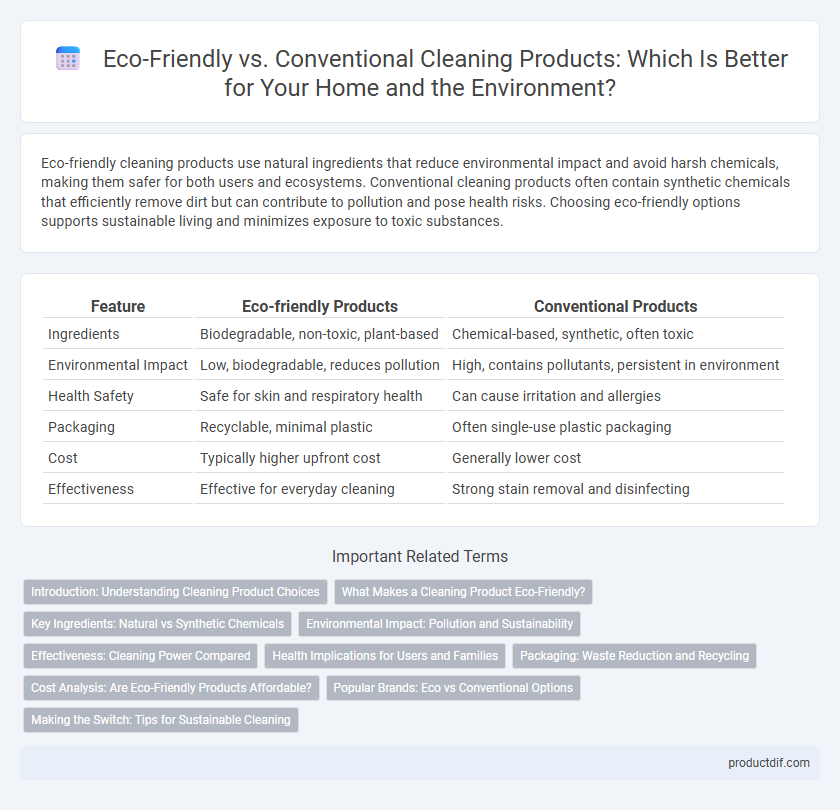Eco-friendly cleaning products use natural ingredients that reduce environmental impact and avoid harsh chemicals, making them safer for both users and ecosystems. Conventional cleaning products often contain synthetic chemicals that efficiently remove dirt but can contribute to pollution and pose health risks. Choosing eco-friendly options supports sustainable living and minimizes exposure to toxic substances.
Table of Comparison
| Feature | Eco-friendly Products | Conventional Products |
|---|---|---|
| Ingredients | Biodegradable, non-toxic, plant-based | Chemical-based, synthetic, often toxic |
| Environmental Impact | Low, biodegradable, reduces pollution | High, contains pollutants, persistent in environment |
| Health Safety | Safe for skin and respiratory health | Can cause irritation and allergies |
| Packaging | Recyclable, minimal plastic | Often single-use plastic packaging |
| Cost | Typically higher upfront cost | Generally lower cost |
| Effectiveness | Effective for everyday cleaning | Strong stain removal and disinfecting |
Introduction: Understanding Cleaning Product Choices
Eco-friendly cleaning products use biodegradable ingredients and natural compounds that reduce environmental impact, promoting sustainability and safer indoor air quality. Conventional cleaning products often contain synthetic chemicals and harsh toxins linked to pollution and health concerns such as respiratory irritation and skin allergies. Choosing between these options involves evaluating effectiveness, safety, and ecological footprint to achieve a balance between cleaning power and environmental responsibility.
What Makes a Cleaning Product Eco-Friendly?
An eco-friendly cleaning product is characterized by biodegradable ingredients, non-toxic formulations, and minimal environmental impact during production and disposal. It avoids harsh chemicals like phosphates, ammonia, and synthetic fragrances that contribute to pollution and health hazards. Packaging often uses recycled or recyclable materials to reduce waste and support sustainability efforts.
Key Ingredients: Natural vs Synthetic Chemicals
Eco-friendly cleaning products primarily use natural ingredients such as plant-based surfactants, essential oils, and biodegradable enzymes that break down dirt without harming the environment. Conventional cleaning products rely on synthetic chemicals like phosphates, chlorine, and ammonia, which can be effective but often pose risks to health and contribute to pollution. Choosing natural key ingredients reduces toxic exposure and supports sustainable practices while maintaining cleaning efficiency.
Environmental Impact: Pollution and Sustainability
Eco-friendly cleaning products significantly reduce environmental pollution by using biodegradable ingredients and minimizing toxic chemical runoff into waterways. Conventional cleaners often contain harmful substances like phosphates and volatile organic compounds (VOCs), which contribute to air and water pollution, disrupting ecosystems. Choosing sustainable cleaning options supports long-term environmental health by lowering carbon footprints and promoting renewable resource use.
Effectiveness: Cleaning Power Compared
Eco-friendly cleaning products utilize natural ingredients that effectively break down grease and grime while minimizing environmental impact. Conventional cleaners often contain stronger chemicals that may offer faster stain removal but can leave harmful residues. Studies show many eco-friendly alternatives match or surpass conventional products in cleaning power, especially on common household surfaces.
Health Implications for Users and Families
Eco-friendly cleaning products reduce exposure to toxic chemicals such as ammonia, chlorine, and phthalates commonly found in conventional cleaners, lowering risks of respiratory issues, skin irritations, and allergies. Families using eco-friendly options benefit from fewer harmful VOCs (volatile organic compounds), creating safer indoor air quality and minimizing long-term health effects. Conventional cleaning products often contain harsh substances linked to asthma exacerbation and endocrine disruption, posing greater health hazards for vulnerable populations like children and pets.
Packaging: Waste Reduction and Recycling
Eco-friendly cleaning products prioritize packaging made from recycled and biodegradable materials, significantly reducing waste sent to landfills. Conventional products often rely on single-use plastics that contribute to environmental pollution. Brands adopting sustainable packaging solutions enhance recycling rates and support circular economy principles.
Cost Analysis: Are Eco-Friendly Products Affordable?
Eco-friendly cleaning products often have a higher upfront cost compared to conventional alternatives, but their long-term savings arise from concentrated formulas requiring less product per use and reduced environmental cleanup expenses. Cost analysis reveals that while initial purchases are pricier, the benefits of non-toxic ingredients and renewable resources lead to fewer health-related costs and less packaging waste. Consumers prioritizing sustainability find eco-friendly options increasingly affordable as market demand drives price competitiveness and wider availability.
Popular Brands: Eco vs Conventional Options
Popular eco-friendly cleaning brands like Seventh Generation and Ecover prioritize biodegradable ingredients and sustainable packaging, reducing environmental impact. Conventional options from Clorox and Lysol often contain stronger chemicals for disinfecting but may contribute to pollution and health concerns. Consumers increasingly choose eco-friendly brands for safer, non-toxic formulations that balance efficacy with environmental responsibility.
Making the Switch: Tips for Sustainable Cleaning
Switching to eco-friendly cleaning products reduces harmful chemicals and minimizes environmental impact while maintaining effective cleaning performance. Use ingredients like vinegar, baking soda, and essential oils to create homemade solutions that are biodegradable and non-toxic. Gradually replace conventional products with certified green alternatives to support sustainability and improve indoor air quality.
Eco-friendly vs Conventional Infographic

 productdif.com
productdif.com